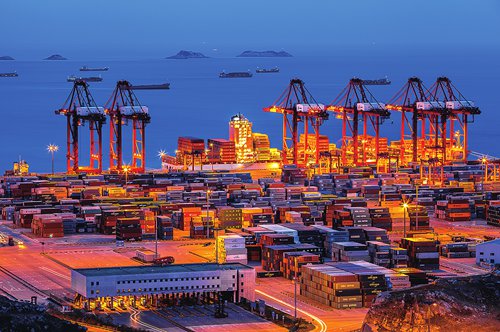METRO SHANGHAI / METRO SHANGHAI
Shanghai’s three-year (2018-20) action plan to build itself into an international shipping center
New goals
The Information Office of Shanghai Municipality held a press conference recently, during which Xie Feng, director of the local transport commission, gave a brief introduction about Shanghai's Three-Year (2018-20) Action Plan to build itself into an international shipping center.
The 13th Five-Year period is of critical importance to the city's plan to build itself into an international shipping center by 2020. To achieve the target and raise the city's core competitiveness, the local government has drafted a three-year plan.
International shipping hub
One goal of the three-year plan is to further consolidate Shanghai's status as an international shipping hub. In the Chinese mainland, the Port of Shanghai boasts the largest number of container shipping routes, the highest frequency of route operations and the widest network coverage. In 2017, cargo throughput rose 6.9 percent from 2016 to 751 million tons at the Port of Shanghai, while container throughput increased 8.3 percent year-on-year to 40.23 million TEUs, ranking first in the world for the eighth consecutive year.
At the same time, leveraging on the golden waterway along the Yangtze River, the Port of Shanghai is developing its waterway-waterway transport business and proceeding with its renovation project on high-grade inland waterways at a steady pace. Container lines connecting all ports along the Yangtze River are operated on a regular basis and breakthroughs have been made in the two-way navigation for large vessels along the deep-water passage at the mouth of the Yangtze River.
In 2017, waterway-waterway transport accounted for 46.7 percent of total container transfer. Among all, 10.58 million TEUs were handled along the Yangtze River, accounting for 56.4 percent of the total waterway-waterway transport and 26.3 percent of total throughput at the Port of Shanghai.
Gateway aviation hub
Another goal of the plan is to generally establish Shanghai's status as an Asian gateway aviation hub. Shanghai has successfully built a "one city, two airports" system, the first of its kind in the country, whose scale and layout are compatible with their international counterparts.
The city's two international airports, namely Pudong and Hongqiao, have a total of four terminals, six runways, 1.47 million square meters' cargo area and an airport bonded zone, with a total designed capacity for 100 million passengers and 5.2 million tons of cargoes. Over 100 airlines have launched services to the city's airports, which are now connected to 297 cities worldwide.
Transit centers of the three largest logistics companies are all under operation in the international cargo mail and courier service zones at the Pudong airport. In 2017, passenger throughput at Shanghai airports reached 112 million, ranking fourth around the globe. Cargo mail throughput at Pudong airport maintained its No.3 global ranking for the 10th consecutive year. Throughput of international passengers and cargo mail at Pudong airport accounted for one-third and half of the country's total, respectively, making it the No.1 gateway in the Chinese mainland.
Modern shipping services
The third aim is to continuously improve Shanghai's function of modern shipping services. A cluster of shipping service areas such as Waigaoqiao, Yangshan-Lingang, North Bund, Wusongkou, Hongqiao, and Pudong Airport, among which the shipping industry in Hongkou district ranks first in terms of its contribution to the district's overall financial income, accounting for 19 percent of Hongkou's public financial income.
A group of international and national shipping functional organizations have gathered in Shanghai. The world's top 20 liner companies, the top four cruise companies, nine global shipping classification societies, and major State-owned and privately owned shipping companies have all set up headquarters or branches in Shanghai.
Shanghai Shipping Exchange has become the national container liner freight registration center and the China Ship Information Center. The container freight index has become a benchmark for the global container shipping market. The capability of maritime legal services has been continuously improved. The number of maritime arbitration cases in Shanghai accounts for 90 percent of the country's total number of cases. Shanghai Maritime Court is striving to build an international maritime judicial center.
The story is based on an article published on Touch Shanghai.


The 13th Five-Year period is of critical importance to the city's plan to build itself into an international shipping center by 2020. To achieve the target and raise the city's core competitiveness, the local government has drafted a three-year plan.
International shipping hub
One goal of the three-year plan is to further consolidate Shanghai's status as an international shipping hub. In the Chinese mainland, the Port of Shanghai boasts the largest number of container shipping routes, the highest frequency of route operations and the widest network coverage. In 2017, cargo throughput rose 6.9 percent from 2016 to 751 million tons at the Port of Shanghai, while container throughput increased 8.3 percent year-on-year to 40.23 million TEUs, ranking first in the world for the eighth consecutive year.
At the same time, leveraging on the golden waterway along the Yangtze River, the Port of Shanghai is developing its waterway-waterway transport business and proceeding with its renovation project on high-grade inland waterways at a steady pace. Container lines connecting all ports along the Yangtze River are operated on a regular basis and breakthroughs have been made in the two-way navigation for large vessels along the deep-water passage at the mouth of the Yangtze River.
In 2017, waterway-waterway transport accounted for 46.7 percent of total container transfer. Among all, 10.58 million TEUs were handled along the Yangtze River, accounting for 56.4 percent of the total waterway-waterway transport and 26.3 percent of total throughput at the Port of Shanghai.
Gateway aviation hub
Another goal of the plan is to generally establish Shanghai's status as an Asian gateway aviation hub. Shanghai has successfully built a "one city, two airports" system, the first of its kind in the country, whose scale and layout are compatible with their international counterparts.
The city's two international airports, namely Pudong and Hongqiao, have a total of four terminals, six runways, 1.47 million square meters' cargo area and an airport bonded zone, with a total designed capacity for 100 million passengers and 5.2 million tons of cargoes. Over 100 airlines have launched services to the city's airports, which are now connected to 297 cities worldwide.
Transit centers of the three largest logistics companies are all under operation in the international cargo mail and courier service zones at the Pudong airport. In 2017, passenger throughput at Shanghai airports reached 112 million, ranking fourth around the globe. Cargo mail throughput at Pudong airport maintained its No.3 global ranking for the 10th consecutive year. Throughput of international passengers and cargo mail at Pudong airport accounted for one-third and half of the country's total, respectively, making it the No.1 gateway in the Chinese mainland.
Modern shipping services
The third aim is to continuously improve Shanghai's function of modern shipping services. A cluster of shipping service areas such as Waigaoqiao, Yangshan-Lingang, North Bund, Wusongkou, Hongqiao, and Pudong Airport, among which the shipping industry in Hongkou district ranks first in terms of its contribution to the district's overall financial income, accounting for 19 percent of Hongkou's public financial income.
A group of international and national shipping functional organizations have gathered in Shanghai. The world's top 20 liner companies, the top four cruise companies, nine global shipping classification societies, and major State-owned and privately owned shipping companies have all set up headquarters or branches in Shanghai.
Shanghai Shipping Exchange has become the national container liner freight registration center and the China Ship Information Center. The container freight index has become a benchmark for the global container shipping market. The capability of maritime legal services has been continuously improved. The number of maritime arbitration cases in Shanghai accounts for 90 percent of the country's total number of cases. Shanghai Maritime Court is striving to build an international maritime judicial center.
The story is based on an article published on Touch Shanghai.

A port in Shanghai Photos: VCG

A View of Shanghai Photos: VCG
